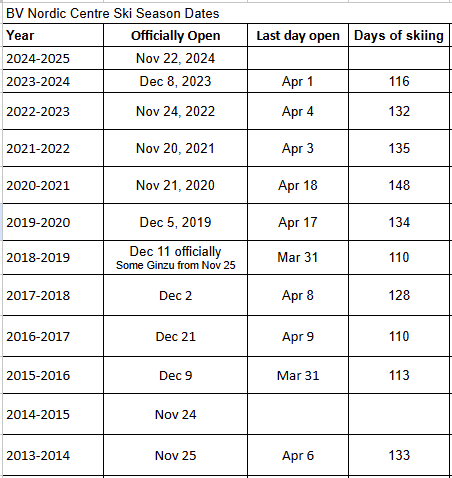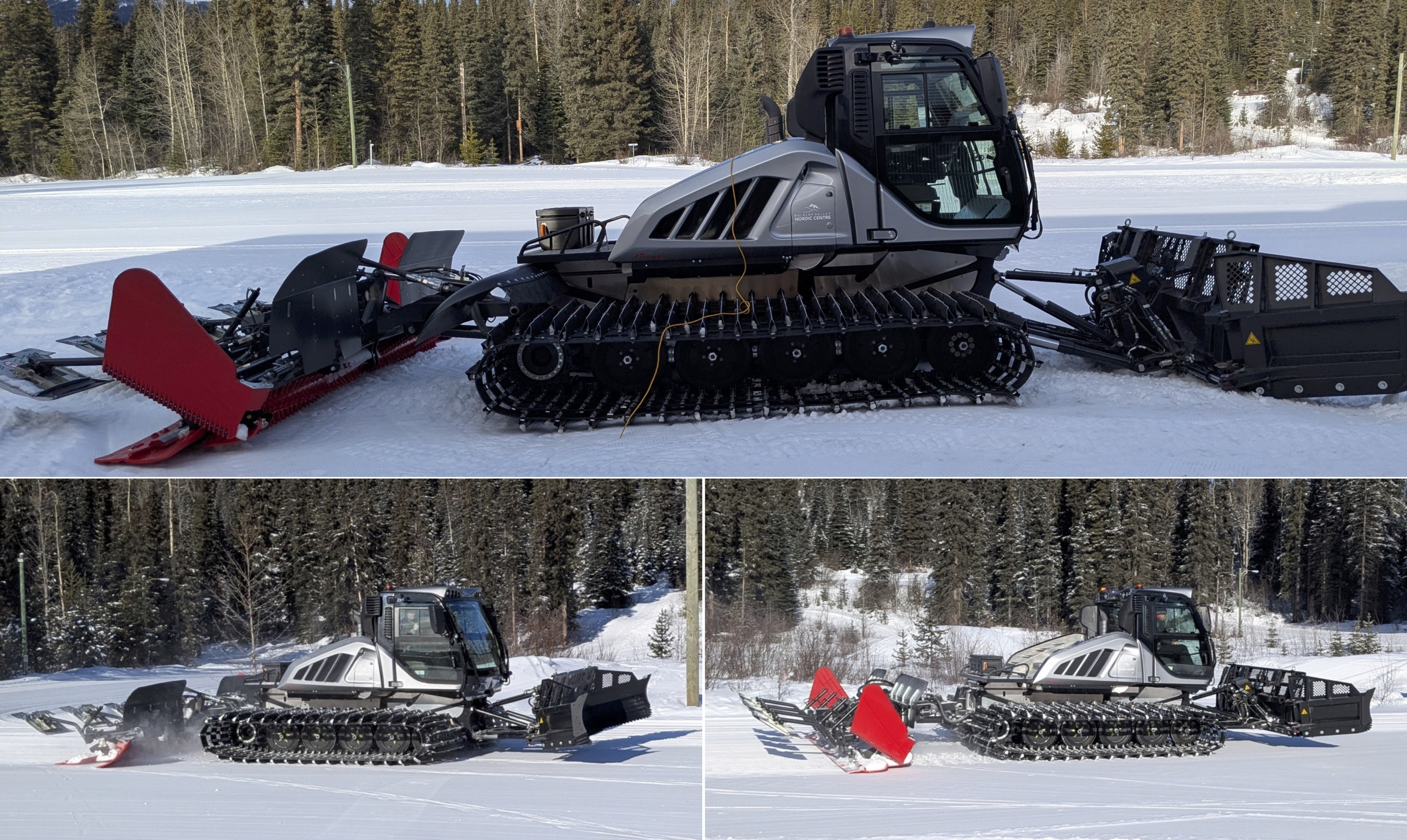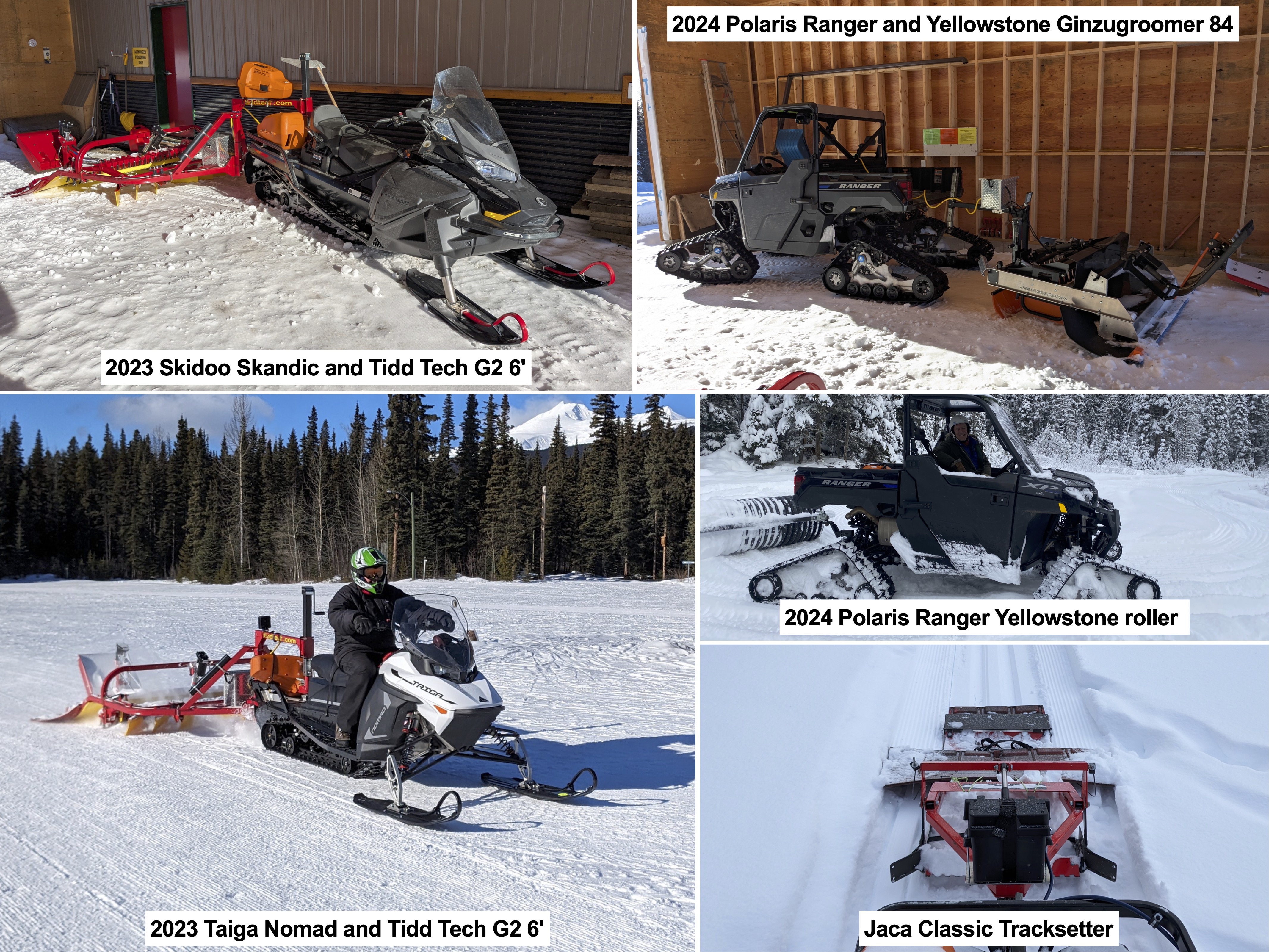Grooming FAQ
When does grooming start and finish each year?
As soon as there is snow, volunteers will start packing it with the snowmobiles and UTV (Ranger side by side). At first they will just use the machines' tracks, then they pull the roller. The compacted snow is the foundation for our ski trails. Compacted snow also has a better chance of surviving fall rains. After a bit more snow, the small machines will pull the G2 or Ginzu to groom and trackset our early-season trails. The Bison snowcat is only used once the snow is deep enough that we are confident it won't bring up rocks and dirt.
At the end of the season, grooming continues as long as we have enough snow, enough skiers and no danger of damaging the machines.
Here are the opening and closing dates for several years:
 .
.
What grooming equipment does our club use?
Our primary tracksetter is a 2024 Prinoth Bison. This modern, capable machine replaces our 2004 PistenBully Edge. We gratefully acknowledge the financial support of the Province of British Columbia through the Ministry of Tourism, Arts, Culture and Sport.
The Bison snowcat has a powerful tiller which can groom and set a 5 metre wide track. In a single pass, our trails can be groomed with 2 classic tracks and 1 skate lane.

We also have an assortment of small grooming tools that are used in the early season, or for special circumstances:
- Tidd Tech G2 6' (renovates ~68"; comb finish 96")
- Yellowstone Ginzugroomer 84 (renovate/compaction box 60"; comb finish 84")
- Yellowstone roller (drum 66”; compactor 72”; comb 80”)
- Jaca classic tracksetter
Our small tracksetters are set up with their own power supply and can be pulled by our fleet of small machines:
- 2023 Taiga Nomad (electric snowmobile donated by Corry & Harvey Tremblay)
- 2023 Skidoo Skandic
- 2024 Polaris Ranger side by side (wheels in summer, tracks in winter)

The smaller machines are used in the early season to prepare a solid base. Once we have enough snow, the Bison takes over and becomes the workhorse for the season. During the ski season we will use the Ginzu or G2 to freshen up trails or to set tracks in some circumstances.
If the Bison is our best machine, why not use it all the time?
The Bison can’t be operated in the early season's low snow conditions due to the depth of the cleats on the tracks and the aggressiveness of the cutters on the tiller. In addition to potential damage to the Bison, it can bring debris to the surface and spread it through the snowpack. The small machines are best for the early season.
During the ski season, the Bison is used most of the time whenever we have new snow or if there is a need to re-groom worn out tracks. However, if we have a long period without fresh snowfall, the grooming team has to decide if, when and how to use the Bison. Each time the snow is tilled, the snow crystals are altered and become finer. This might improve the skiing surface in the short term but could also create hard, icy surface. The G2 and Ginzu might be the better tools in some situations because they have less aggressive action and do not alter the snow crystals as much.
In the spring, during freeze/thaw cycles, the snow surface melts in the day then freezes into ice at night. The Bison's blade and tiller can do a great job of chewing up the ice but each time this is done, the snowpack is reduced and the ability of the snow crystals to adhere to each other can be diminished. Snow crystals have a finite capacity to be worked. We will still groom spring snow but there is a lot of science, art and luck in deciding on the frequency and timing that will best extend the season. Often, the best approach on some days is to simply scratch up the skate lane with a small groomer.
Throughout the ski season, the grooming team strives to use the best tool at the best time to provide the best skiing for as long as possible.
Why is the skate lane soft sometimes?
Fresh snow makes for beautiful tracks, but…. fresh snow has lots of air in it and takes time and work to “set up” into a firm skate track. The Bison has a tiller that spins and turns over the snow which really helps work the air out of the snow. Still, after a deep snowfall, it may take more than one pass and more than a day before the skate late firms up. When we get deep snow on the trails, we will try to open as many trails as quick as we can, but with over 50 km of trails and multiple priorities to address, it may take some time to get everything as perfect as we all would like. If we get a series of snowfalls, our efforts will be focused on keeping high use trails open so an extra, track-firming pass may get further delayed. Please be patient; fresh snow is a blessing and with a bit of time the trails will become amazing again.
Why wasn’t my favourite trail groomed?
The goal of the club is to have outstanding trails when snow conditions allow. Every day some trails will be set after a snowfall. We start with the most heavily used trails but cannot set all our trails immediately. Priority trails that are usually set first are the dog trails, Broadway and trails close to the lodge, and the logging roads.
How long does it take to groom all trails?
The club has over 50 km of trails and, depending on snow conditions, the Bison grooms at about 5 to 10 km per hour. In theory, it could take less than 6 hours, but in practice, grooming all the trails will take 10 hours or more due to extra time on junctions, connecting trails, out-and-back trails, and removing fallen trees.
What time of day are trails usually groomed?
Be aware that grooming could be happening at any time of the day or night. Our preferred times are late evening and early morning. These times avoid most skier traffic and gives the groomed surface more time to firm up before being used by skis and dogs. When there is overnight snow in the forecast, grooming will be scheduled for early morning to better facilitate the compaction of fresh snow onto the trails. Weather conditions (new snow, warm days, rain, etc.) may cause the grooming team to adapt their schedule to provide the best trail surface conditions for users.
It snowed and there were not many trails set; how come?
If it snows heavily during the day, we may not be able to set trails that day. Usually, groomers are scheduled for the evening or mornings. Grooming during a daytime snowfall will interfere with skiers and could still result in snowed-in tracks at the end of the grooming shift.
Another time when it may not be feasible to set trails is after a wet snowfall, usually around freezing. Moisture in the snow makes for great snowball fights but clogs up the Bison's tiller. Often, if a trail is groomed when its really wet, it will become icy later. In these conditions, we may be able to set a small amount of trail with the Ginzu, the Roller, or the Jaca (classic track only). Our best strategy is usually to wait until evening or the next day when cooler temperature dries out the snow and allows the equipment to do a good job.
The PistenBully seemed to break down a lot; Is that going to happen with the Bison?
A snowcat is a complex piece of machinery with multiple hydraulic pumps and lots of moving parts. Any major piece of machinery will experience occasional downtime. Our PistenBullly was over 20 years old and despite considerable effort and money on pro-active maintenance, we were having more and more unexpected and expensive breakdowns. It even broke down the week before the scheduled delivery of our 2024 Prinoth Bison. The Bison is even more complex but being new, it should experience way less downtime. Our operators are being VERY careful with the machine and it is getting regular servcing. So downtime will hopefully be minimal in the years to come. The club has backup strategies in place to ensure that we can continue grooming if and when the Bison is unavailable. We have several auxiliary machines and lots of trained operators ready to go whenever there is a problem. Those machines and people are also ideal for low-snow conditions or for supplemental grooming on the adventure trail and Berminator.
How can skiers help with trail conditions?
You will help the trails if you can avoid skiing right after a trail has been groomed. It takes at least an hour or even overnight for the snow to set up and provide solid tracks and that lovely firm corduroy skate lane. If you come across a tracksetting machine while you are skiing, please get off the trail in a place that the operator can see you. Make eye contact and stay still or move farther away if directed. After the machine passes, please ski to the nearest junction and use an alternate route while the tracks firm up.
It is OK and greatly appreciated to clip small branches or brush on the trails. Despite our summer trail brushing, snow-covered brush will lean over onto the trail edge. No chain sawing unless you have first checked with the groomers and you follow the club’s safety rules.
Where do I direct my grooming compliments and suggestions?
Send feedback about ski trails to trails@bvnordic.ca. Your comments are appreciated and will be read but you may not receive a reply. We want our groomers to spend their time on the trails.
General comments and questions about the club can be sent to feedback@bvnordic.ca. A club volunteer will try to respond if you have a question.
